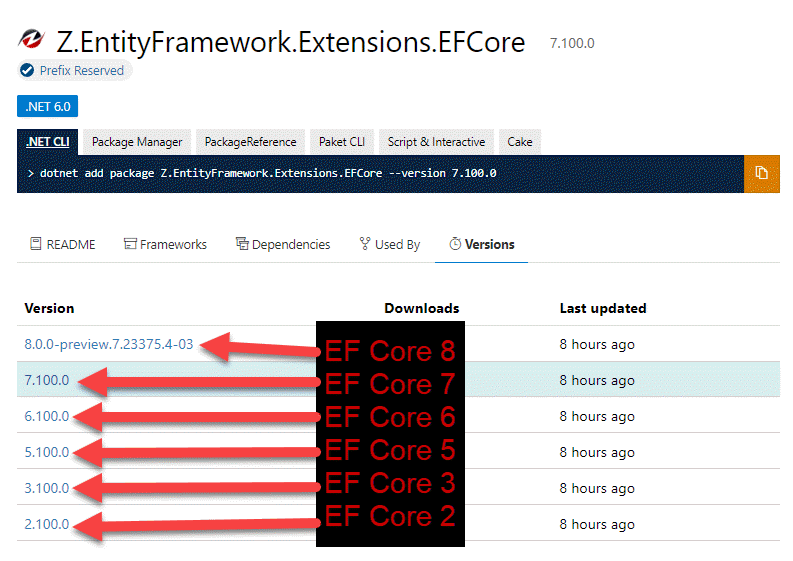EFCore-Pinned Versioning
The EFCore-Pinned Versioning is the specific versioning conventions used by both Entity Framework Extensions and Entity Framework Plus libraries.
To make the explanation below simpler, we will only provide examples with Entity Framework Extensions also named EFE.
What is EFCore-Pinned Versioning?
EFCore-Pinned Versioning extends traditional Semantic Versioning by introducing a significant adjustment: the addition of the EF Core version at the beginning, shifting all other version components to the right.
Traditional Semantic Versioning follows the format:
- [major].[minor].[patch] (e.g.,
7.2.1)
In contrast, EFCore-Pinned Versioning incorporates the [efcore-version] at the beginning:
- [efcore-version].[major].[minor].[patch] (e.g.,
7.100.0.1for Entity Framework Extensions usingEF Core 7)
The [efcore-version] directly corresponds to the EF Core version:
7.x.y.z: For EFE usingEF Core 76.x.y.z: For EFE usingEF Core 65.x.y.z: For EFE usingEF Core 5
Incrementing the x value typically indicates a major release, which often indicates a breaking change.
NOTE: On NuGet, when the [patch] value is 0, it doesn't appear in the version number. For example, a release like 7.100.0.0 will be displayed on NuGet as 7.100.0. Keep this in mind when comparing version numbers between our release notes and NuGet listings.

Why use EFCore-Pinned Versioning?
EFCore-Pinned Versioning provides a mechanism to a library like Entity Framework Extensions to simultaneously support multiple versions of EF Core while still being able to introduce major version releases.
To concurrently support various product or platform versions, two primary strategies exist:
- Launch a uniquely named library for each major release of the product/platform.
- Pin the first version number to the product/platform version.
Considering that EF Core releases a new major version every year, creating a new package of Entity Framework Extensions can become confusing. The option 2 approach proves more intuitive and accessible.
Benefits of EFCore-Pinned Versioning
The primary advantages are the ability to support several EF Core versions concurrently within the same package name and to indicate breaking changes with major version increments.
Why not just use Semantic Versioning?
While Semantic Versioning serves many projects well, it presents challenges when supporting multiple versions of EF Core under a single package name.
EF Core itself faces challenges with Semantic Versioning. For instance, if EF Core releases version 8.0.0 and later discovers a significant bug necessitating breaking changes, they can't easily transition to version 9.0.0 since the first number of their versioning aligns with the latest .NET release.
In essence, EF Core adopts a .NET-Pinned Versioning approach, where the first number corresponds with the most recent .NET version, regardless of the minimum required .NET version (e.g., EF Core 7 requires .NET 6 and not .NET 7).
How does it apply to Entity Framework 6?
For clarity in the release notes, Entity Framework Extensions for EF6 will always adopt the highest available EF Core version. This means that when .NET 8 / EF Core 8 is released, EFE for EF6 will start with the version format 8.x.y.z.
This can also be viewed as a .NET-Pinned Versioning approach, which we discussed in the previous section.
How are release notes managed?
For simplicity in our release notes, all modifications are listed under the highest available stable EF Core version. Even if a change only affects Entity Framework Extensions using EF Core 6, we release packages for all EF Core versions, adding the changes to the notes under the latest release.
For example, release notes might be displayed under 7.100.0.1 (the patch part was incremented to 1), even if the fix was exclusively for Entity Framework Extensions using EF Core 6.
Who Adopts EFCore-Pinned Versioning?
While we can't pinpoint every library's exact versioning strategy, several third-party EF Core libraries have adopted a similar approach:
EFCore-Pinned Versioning in Action
The Entity Framework Extensions library introduced a breaking change in its release on 2023-09-12. Highlighted features of this release included:
- The formal adoption of EFCore-Pinned Versioning.
- A major breaking change within the IncludeGraph feature.
These modifications included a breaking change, consequently requiring the major version to be incremented to 100 resulting in the release of the following packages:
- v7.100.0.0: for EFE using
EF Core 7 - v6.100.0.0: for EFE using
EF Core 6 - v5.100.0.0: for EFE using
EF Core 5 - v3.100.0.0: for EFE using
EF Core 3 - v2.100.0.0: for EFE using
EF Core 2 - v7.100.0.0: for EFE using
EF6
ZZZ Projects